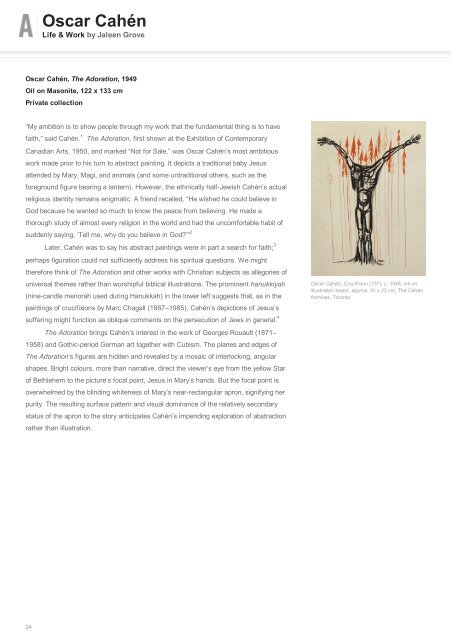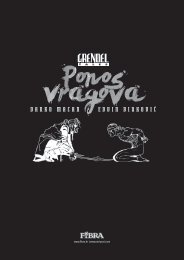Oscar Cahén
Art-Canada-Institute_Oscar-Cah%C3%A9n
Art-Canada-Institute_Oscar-Cah%C3%A9n
You also want an ePaper? Increase the reach of your titles
YUMPU automatically turns print PDFs into web optimized ePapers that Google loves.
<strong>Oscar</strong> <strong>Cahén</strong><br />
Life & Work by Jaleen Grove<br />
<strong>Oscar</strong> <strong>Cahén</strong>, The Adoration, 1949<br />
Oil on Masonite, 122 x 133 cm<br />
Private collection<br />
“My ambition is to show people through my work that the fundamental thing is to have<br />
1<br />
faith,” said <strong>Cahén</strong>. The Adoration, first shown at the Exhibition of Contemporary<br />
Canadian Arts, 1950, and marked “Not for Sale,” was <strong>Oscar</strong> <strong>Cahén</strong>’s most ambitious<br />
work made prior to his turn to abstract painting. It depicts a traditional baby Jesus<br />
attended by Mary, Magi, and animals (and some untraditional others, such as the<br />
foreground figure bearing a lantern). However, the ethnically half-Jewish <strong>Cahén</strong>’s actual<br />
religious identity remains enigmatic. A friend recalled, “He wished he could believe in<br />
God because he wanted so much to know the peace from believing. He made a<br />
thorough study of almost every religion in the world and had the uncomfortable habit of<br />
suddenly saying, ‘Tell me, why do you believe in God?’”<br />
Later, <strong>Cahén</strong> was to say his abstract paintings were in part a search for faith;<br />
perhaps figuration could not sufficiently address his spiritual questions. We might<br />
therefore think of The Adoration and other works with Christian subjects as allegories of<br />
universal themes rather than worshipful biblical illustrations. The prominent hanukkiyah<br />
(nine-candle menorah used during Hanukkah) in the lower left suggests that, as in the<br />
paintings of crucifixions by Marc Chagall (1887–1985), <strong>Cahén</strong>’s depictions of Jesus’s<br />
suffering might function as oblique comments on the persecution of Jews in general.<br />
The Adoration brings <strong>Cahén</strong>’s interest in the work of Georges Rouault (1871–<br />
1958) and Gothic-period German art together with Cubism. The planes and edges of<br />
The Adoration’s figures are hidden and revealed by a mosaic of interlocking, angular<br />
shapes. Bright colours, more than narrative, direct the viewer’s eye from the yellow Star<br />
of Bethlehem to the picture’s focal point, Jesus in Mary’s hands. But the focal point is<br />
overwhelmed by the blinding whiteness of Mary’s near-rectangular apron, signifying her<br />
purity. The resulting surface pattern and visual dominance of the relatively secondary<br />
status of the apron to the story anticipates <strong>Cahén</strong>’s impending exploration of abstraction<br />
rather than illustration.<br />
2<br />
3<br />
4<br />
<strong>Oscar</strong> <strong>Cahén</strong>, Crucifixion (737), c. 1948, ink on<br />
illustration board, approx. 31 x 23 cm, The <strong>Cahén</strong><br />
Archives, Toronto<br />
Maclean’s cover illustration 1952<br />
24



